Glon for Ensemble, Chorus and Electronics: Pitches and Rhythmic organizations
Keywords:
Glon, Contemporary Music, Chorus, ElectronicsAbstract
The composition Glon for ensemble, chorus and electronics is an original contemporary classical music. It was composed as a creative work which blends Thai elements, the western music and electronic sounds together. The piece was created via techniques which combining the concept of automated music especially Integral Serialism and self-repetition with sonorities of Thai words and prosody. Glon matched elements of words in “Glon”, a kind of Thai prosody, with music elements in western practice based on Integral Serialism techniques as well as usages of the Spiral Row which is an unconventional way of 12 tones serialism implementation. Then the sounds of acoustic instrument and chorus are expanded by electronics. After preliminary processes of collecting musical materials and structural planning, the piece was developed then combined all these elements together. The outcome is a piece of music which has varieties in rhythms, melodies, harmonies and timbres. Furthermore, the work also yields interesting structure and musical aesthetic. However, this composition is highly challenged for musician. It is a demanding work for both performance practice and arrangement which requires adequate rehearsals and an efficient preparation.
References
2. อุปกิตศิลปสาร, พระยา. หลักภาษาไทย. กรุงเทพฯ: ไทยวัฒนาพานิช, 2546.
3. เมธาวี เลิศรัตนา. “ทฤษฎีไร้ระเบียบ.” ใน วิศิษฐ์ วังวัญญู (บ.ก.), กรุงเทพฯ: มูลนิธิเด็ก, 2549.
4. วิบูลย์ ตระกูลฮุ้น. ดนตรีศตวรรษที่ 20 : แนวคิดพื้นฐานทฤษฎีเซต. กรุงเทพฯ: สำนักพิมพ์แห่งจุฬาลงกรณ์มหาวิทยาลัย, 2559.
5. Cornicello, Anthony. “Timbral Organization in Tristan Murail’s Désintégrations.” Ph.D. diss., Brandeis University, 2000
6. Di Pietro, Rocco. Dialogues with Pierre Boulez. Lanham, MD: Scarecrow Press, 2001.
7. Griffith, Paul. Modern Music and After .3rd ed. New York: Oxford University Press, 2010.
8. Kennedy, Machael. “Through-Composed.” In The Oxford Dictionary of Music. 6th ed., edited by Tim Rutherford-Johnson, Michael Kennedy, and Joyce Bourne. Oxford: Oxford University Press, 1985.
9. Kostka, Stefan. Materials and Techniques of Twentieth-Century Music. 2nd ed. Upper Saddle River, NJ: Prentice-Hall, 1999.
10. Miranda, Euardo R. Computer Sound Design: Synthesis Techniques and Programming. 2nd ed. Oxford: Focal Press, 2002.
11. Oliver, Michael. Igor Stravinsky. London: Phaidon, 1995.
12. Paul, David. “Karlheinz Stockhausen by David Paul.” Accessed August 12, 2015. http:// www.stockhausen.org/stockhausen%20_by_david_paul.html
13. Service, Tom. “A guide to Karlheinz Stockhausen’s music.” Accessed November 4, 2014. http://www.theguardian.com/music/tomserviceblog/2013/may/07/ contemporary-music-guide-karlheinz-stockhausen
14. Steinitz, Richard. György Ligeti: Music of Imagination. Boston, MA: Northeastern University Press, 2003.







